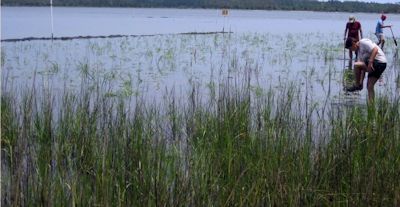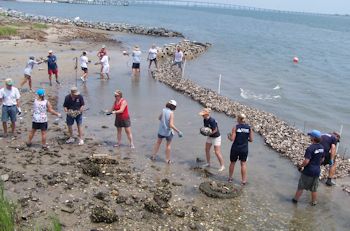 This living shoreline replaced a failing bulkhead at a state boat ramp on the Chowan River. |
 Volunteers help plant grass seedlings at a living shoreline project at Jones Island in the White Oak River in Onslow County. The island is part of Hammocks Beach State Park. |
As research increasingly supports what environmental groups have argued for years – that manmade shorelines that mimic nature are better for estuaries than rock or wooden seawalls and bulkheads – state officials are examining ways to promote these projects, including streamlining the permitting for them.
The N.C. Division of Coastal Management recently launched an educational campaign to spread the word about living shorelines to coastal residents and developers. State officials are also looking into ways to bolster financial incentives to those who choose to do these types of projects.
Supporter Spotlight
It’s a step in the right direction, supporters say, but one that does not address permitting living shorelines. That process, they say, is a major disincentive for property owners because it can be time consuming, arduous and expensive compared to other beach stabilization alternatives.
It is easier in this state to obtain a permit for a bulkhead than a living shoreline, which is why there are a lack of such projects along the coast, said Tracy Skrabal, a coastal scientist and manager of the N.C. Coastal Federation’s Southeast Regional Office in Wilmington.
“For living shoreline projects it is an extensive application and review process,” she said. “The bulkhead permit with the state can be issued in the field within a day. There is a huge incentive in that application process.”
Construction of a marsh sill, a structure parallel to a shore that can be made of rock, oyster shell or vegetation, requires a Coastal Area Management Act permit. Which type of permit, whether general or major, is determined by the design of the structure, proposed location and potential effects its construction may have in the area where it is built.
A general permit can be issued within a few days, but the process requires the applicant to coordinate directly with the state Division of Water Quality and the U.S. Army Corps of Engineers.
Supporter Spotlight
Proposed sill projects that do not qualify for a general permit must go through a CAMA major permit process. These permits require coordination with upwards of 14 state and federal review agencies and take an average of 75 to 90 days to complete.
 Volunteers relay bags full of oyster shells to create a living shoreline at Jockey’s Ridge State Park in Nags Head. |
Living shoreline projects are more complex than other stabilization methods, state and federal officials say, which is why the review process is more stringent.
“We’ve got laws that we have to fulfill, that we have a responsibility to,” said Henry Wicker, assistant chief of the Regulatory Division for the Corps of Engineers Wilmington District.
Sills pose potential effects on essential fish habitats and endangered species. And, because they’re constructed under water away from the shoreline, they raise concerns about posing navigational hazards.
“We’re not against living shoreline projects at all,” Wicker said. “It’s kind of a catch-22. It’s a good project, but it needs to be reviewed.”
Harry Thompson said the review process he underwent to obtain a permit to install a rock marsh toe revetment along his property on Bogue Sound went fairly quickly. The project, which cost him about $6,000, included a shoreline length of about 100 feet and six feet wide.
“It was just a simple matter of having to work up a rough sketch of what you wanted to do,” he said.
Thompson said he preferred a living shoreline because a bulkhead would have caused damage and loss of soil to his property.
“When you put hardened structures at the location where this revetment is it’s only going to cause more damage,” he said. “The grass was receding and now that’s no longer happening. Grass is now growing in the rock and stone area that was placed.”
Thompson said he couldn’t have done the project if he had had to apply for a major permit.
“The major permit, that would have been for a homeowner, I think, cost prohibitive,” he said. “It’s just beyond belief.”
Daniel Govoni, assistant major permits coordinator with the Division of Coastal Management, said the state has discussed the possibility of streamlining the permitting process with the various reviewing agencies.
“Coastal Management has really taken a strong look at this in the last year,” Govoni said. “We’re not disagreeing that there’s a lot of research out there that these are a benefit in certain situations.”
The Division of Coastal Management studied 27 marsh sills in the state. The agency’s final report, released in April 2011, points out that bulkheads are the primary stabilization method used along the state’s more than 9,000 miles of estuarine shoreline.
 Juncus seedlings await planting for a living shoreline project. |
Marsh sills reviewed in the study protected the shore from erosion, were not found to be navigational hazards and allowed water, fish and other aquatic animals better access to the area behind the sill. The sills observed did not affect water quality and supported marsh grass.
Still, various state agencies that are part of the review process, including Wildlife Resources Commission, Division of Water Quality and Division of Marine Fisheries, argue that marsh sills require case-by-case review.
The state Department of Environment and Natural Resources recently asked the division to look into promoting living shorelines and conduct further research into these types of stabilization projects.
Govoni said that the number of living shoreline permit applications are small compared to other stabilization permits.
“There’s not that many of these projects,” he said. “I think it’s just that the word needs to get out there that these are a benefit. You can’t tell somebody what to build. I think the more that are built it will catch on. We’ve tried hard on the timeline. We’re going to try to hold annual workshops explaining living shorelines. We’re going to try to find some more money. I think the financial incentives are going to be very important.”
The state Division of Soil and Water Conservation’s Community Conservation Assistance Program currently offers incentives for estuarine shoreline stabilization projects.
The program is available to all private and public landowners who use what is referred to as best management practices to improve water quality. Among best management practices approved for funding: riparian buffers, stream bank and shoreline protection and marsh sills, according to the division’s web site.
 Todd Miller |
Each project is eligible to receive up to 75 percent reimbursement. Marsh sill projects are reimbursed up to 75 percent with a $5,000-cap.
The state needs to create a more expeditious living shoreline permitting process, environmentalists say.
“We’ve had these discussions for a long time in at least trying to level the playing field,” said Todd Miller, the N.C. Coastal Federation’s executive director. “Throughout the country, other states seem to be able to facilitate and overcome the obstacle.”
Alabama, for example, has a general permit that requires much less of a review process.
“We were curious when we saw the Alabama permit and how they were able to expedite the permitting process,” Miller said. “There’s not a whole lot of oversight.”
Craig Litteken, chief of the Regulatory Division of the Corps of Engineers Mobile District, said the permitting process there was expedited in response to requests from the 100-1000: Restore Coastal Alabama Partnership, a public and private coalition to build 100 miles of oyster reefs and plant and promote 1,000 acres of marsh.
“We’ve had a number of agencies and special interest groups explore living shorelines over the years,” Litteken said. “The argument was you can do ripraps and bulkheads all day long and not living shorelines.”
In October 2011, Alabama issued a permit that “puts most living shoreline projects on the same playing field as other projects such as riprap and bulkheads,” he said.
“Not all living shorelines that are proposed to us will qualifying for the living shoreline permit,” he said. “The general permit can be something very quick. Depending on the workload we can get those out in a matter of 30 days. There’s some projects that, when it gets large enough, we may still evaluate under the individual permit. If we determine there’s an impact we try to work with that applicant.”
In talking with other East Coast districts, Litteken said one of the differences in Alabama is the fact that its coastline has relatively small tides.
Greater tidal fluctuation could play a factor in why other states require a more stringent permitting process.
Litteken said he didn’t know how many permits had been issued since October 2011. The permitting process will be reevaluated in 2016.
“We’re hoping that it works as well as intended, but we’ll see,” Litteken said.







